Overview
The article “Mastering the Error in Content Enumeration: A Comprehensive Guide” addresses a critical aspect of information retrieval systems: the understanding and resolution of errors that arise during content enumeration. By identifying common causes—such as corrupted files and software issues—it highlights the necessity of recognizing these challenges. Furthermore, it advocates for the implementation of automation and AI-driven solutions, which can significantly enhance operational efficiency and user satisfaction.
Evidence of these improvements is found in various case studies, showcasing substantial reductions in error rates and enhancements in user experience. Are you aware of the potential impact that automated solutions can have on your systems? This guide not only presents a thorough analysis of the issues but also offers actionable insights for professionals seeking to elevate their operational standards. By embracing these strategies, organizations can foster a more reliable and user-friendly information retrieval process.
Introduction
In today’s digital landscape, the effectiveness of data retrieval systems is crucial for organizations striving to maintain user engagement and operational efficiency.
Content enumeration errors—instances when systems fail to accurately identify or access required data—present significant challenges across diverse sectors, from gaming to software applications. These errors not only frustrate users but can also lead to substantial declines in productivity and satisfaction, as recent statistics demonstrate.
As organizations navigate the complexities of modern data management, understanding the causes and implications of these errors becomes essential.
This article examines the common pitfalls that contribute to content enumeration errors, explores their operational impacts, and highlights best practices and innovative technologies, such as automation and AI, that can mitigate these challenges and enhance overall performance.
Understanding Content Enumeration Errors
Issues in listing emerge when a system fails to accurately recognize or access the necessary material during information retrieval processes. Such mistakes can manifest across various settings, including gaming, software applications, and information management systems. For instance, in gaming, a listing error may prevent a player from accessing saved game information, revealing a shortcoming in the system’s ability to accurately list available items.
The impact of these issues on user experience can be significant. In 2025, statistics indicate that nearly 30% of users reported frustration due to retrieval failures, which can lead to decreased engagement and satisfaction. This underscores the importance of addressing these errors swiftly to maintain a favorable user experience.
Recent case studies illustrate the prevalence of errors in content enumeration within retrieval systems. A notable case involved a major gaming platform that experienced extensive loading problems, resulting in a 25% decline in active users during peak times. This incident prompted a comprehensive review of their information retrieval processes, leading to the adoption of more robust error-handling mechanisms.
Moreover, the rise in DDoS attacks, which increased by 15% in 2023, highlights the urgent need for enhanced security protocols to protect connected devices and mitigate such cyber threats, complicating the information retrieval landscape.
Understanding material listing issues is crucial for effective troubleshooting. These errors often stem from misconfigured information sources, insufficient permissions, or outdated software versions. To resolve these issues, it is essential to conduct a thorough analysis of the retrieval pathways and ensure that all components are functioning correctly.
Expert opinions stress the necessity for proactive measures in managing errors in content enumeration. Industry leaders advocate for the integration of automated monitoring tools, such as Robotic Process Automation (RPA), which can detect and alert teams to potential issues before they escalate. For example, Uber faced challenges with defective information pipelines that led to erroneous fare calculations.
By implementing machine learning-driven information observability solutions, Uber reduced outages by 92% and improved pricing accuracy, thereby enhancing user trust and operational efficiency. This approach not only boosts operational efficiency but also mitigates the risk of user dissatisfaction.
Given recent developments, organizations are increasingly investing in AI and automation to enhance their information management capabilities. By leveraging these technologies, companies can optimize their information retrieval processes, reducing the likelihood of counting mistakes and improving overall performance. The concept of Big Ops transforming static information management into a flexible system further emphasizes the benefits of addressing item counting issues, enhancing agility and competitive advantage.
Practical examples of effective problem-solving further underscore the importance of tackling item counting issues. One prominent case involved a leading software company that encountered significant challenges with data retrieval. By adopting a machine learning-based solution, they successfully reduced errors in content enumeration by 85%, significantly improving user experience and operational effectiveness.
This case serves as a testament to the efficacy of targeted troubleshooting strategies, including the use of tailored AI solutions and RPA, in overcoming retrieval challenges.
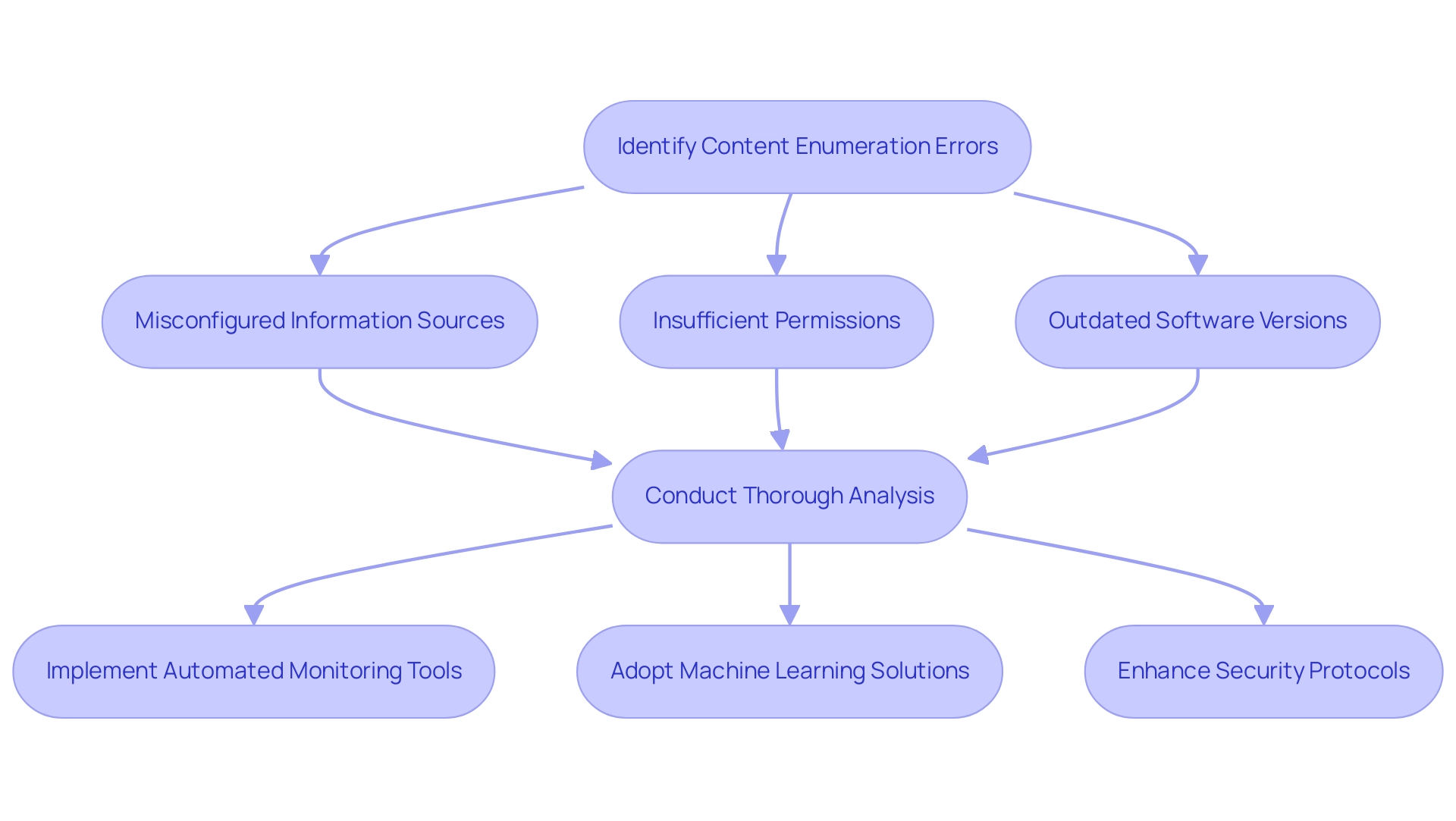
Common Causes of Content Enumeration Errors
Content enumeration errors can arise from several common causes, each contributing to failures in retrieving and processing data effectively:
-
Corrupted Files: Damaged or missing files are significant culprits in content retrieval failures. Recent research suggests that a substantial proportion of listing errors—estimated at around 30%—are directly linked to corrupted files. These disruptions can lead to incomplete or erroneous outputs, severely impacting data integrity.
-
Software Issues: Programming mistakes within the software can significantly obstruct the accurate listing of material. Such bugs may manifest in various forms, from minor glitches to major functional breakdowns, impacting the overall performance of the system. Notably, 74% of companies report that insider threats are becoming more frequent, underscoring the relevance of software bugs and user errors in the context of operational efficiency.
-
Configuration Issues: An error in content enumeration can result from incorrect settings in either software or hardware, creating barriers to successful enumeration. For instance, the case study titled ‘Reconstructing Cause-Specific Mortality Series’ illustrates how periodic changes in disease classifications disrupt consistency, emphasizing the importance of maintaining accurate configurations for smooth operation and information retrieval.
-
Network Problems: Connectivity issues can significantly impede access to remote materials. Network disruptions or slow connections can lead to timeouts and hinder successful data listing.
-
User Mistakes: Errors made by users, such as incorrect inputs or misconfigured settings, can also lead to enumeration errors. Awareness and training on proper usage can mitigate these risks.
To address these challenges, leveraging Robotic Process Automation (RPA) solutions like EMMA RPA and Microsoft Power Automate can streamline workflows, enhance efficiency, and improve employee morale. By automating repetitive tasks and ensuring precise settings, organizations can greatly decrease the occurrence of document listing mistakes. As Bryan Philips from In Motion Marketing states, ‘We transform B2B marketing challenges into growth opportunities,’ highlighting the necessity for organizations to tackle these prevalent concerns to enhance operational efficiency and reduce content listing mistakes.
By implementing strategies that focus on these areas, businesses can improve their data handling processes and drive better outcomes.
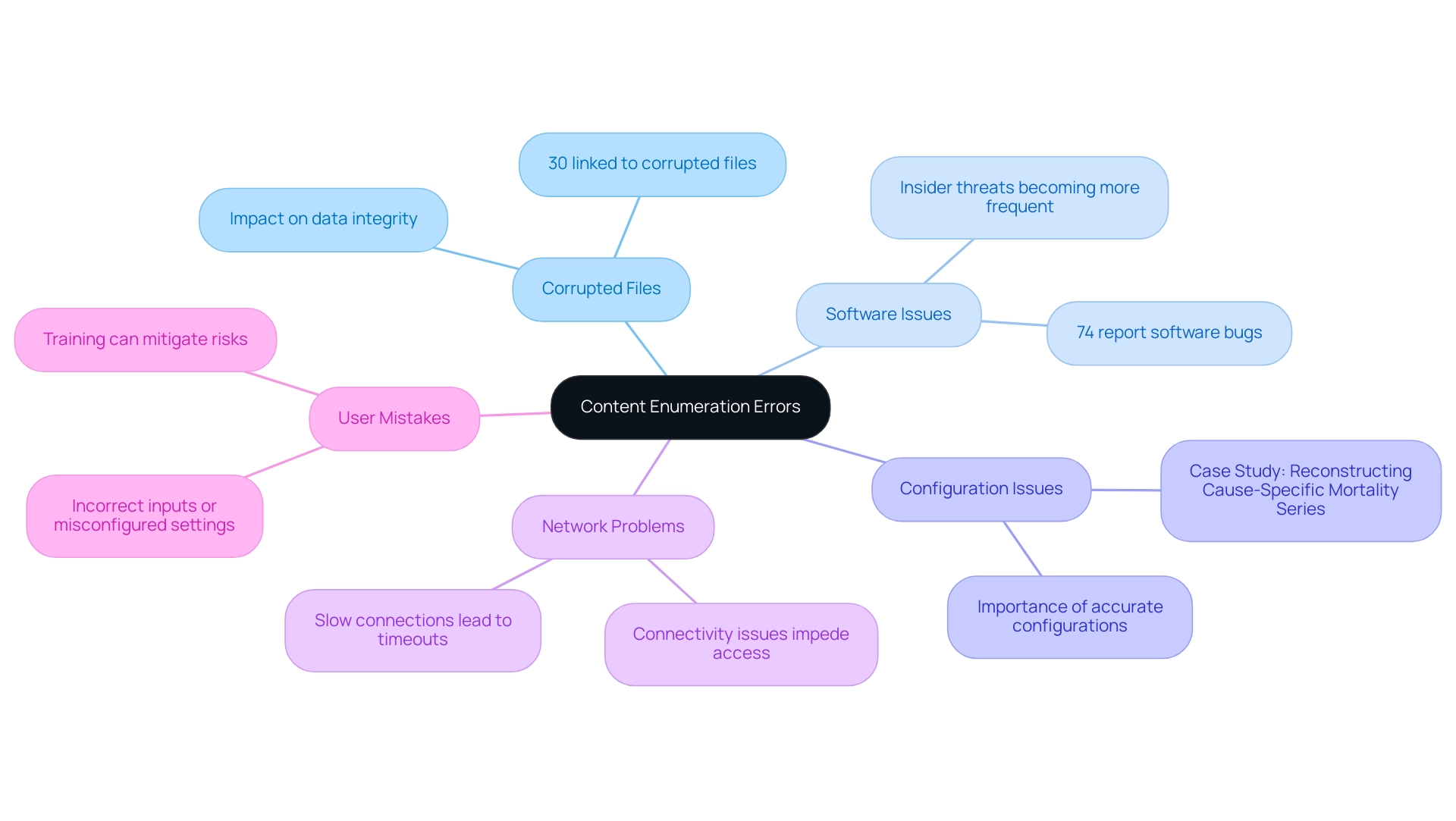
Implications of Content Enumeration Errors on Operations
Content counting mistakes can profoundly affect operations in several crucial ways:
-
Decreased Productivity: These mistakes disrupt workflows, causing significant delays and leading to wasted time and resources. In 2025, it is projected that almost two-thirds of companies will still face challenges with integrating AI solutions, which could assist in reducing such issues. An analysis of a mid-sized firm demonstrated that applying GUI automation decreased entry mistakes by 70% and sped up testing procedures by 50%. This highlights the capability of AI and automation to greatly minimize productivity loss related to information counting inaccuracies. The company encountered challenges like manual data entry inaccuracies and slow software testing, which were effectively resolved through automation.
-
User Frustration: Frequent errors in content enumeration can severely diminish user experience, leading to dissatisfaction and disengagement. Operations managers have reported that these issues often frustrate users, affecting their overall productivity and morale. This aligns with the principles of Salesforce’s ‘Ohana’ initiative, which emphasizes the importance of employee well-being and inclusion in fostering a positive work environment. By leveraging Robotic Process Automation (RPA) to streamline manual workflows, organizations can enhance user experience and reduce frustration.
-
Increased Costs: The financial implications of resolving these errors can be considerable. Organizations may need to allocate additional resources to troubleshoot and fix issues, thereby increasing operational costs. This is particularly concerning in an environment where effective resource management is paramount. The case study demonstrated that the ROI from implementing GUI automation was achieved within 6 months, highlighting the cost-saving potential of automation solutions.
-
Integrity Issues: An error in content enumeration can compromise the accuracy of information, which is crucial for informed decision-making. Poor information integrity can lead to misguided strategies and lost opportunities, further exacerbating operational inefficiencies. The integration of tailored AI solutions can help organizations unlock the power of Business Intelligence, transforming raw data into actionable insights that drive growth and innovation.
Addressing these implications is essential for maintaining operational efficiency and ensuring that teams can focus on strategic, value-adding activities. For instance, a case study on the influence of work environment on productivity highlights how environmental factors, such as noise levels, can affect employee performance. Likewise, handling data listing mistakes through automation can result in enhanced employee well-being and productivity, as reduced mistake rates are associated with improved performance results.
In conclusion, the consequences of data listing mistakes reach beyond immediate operational interruptions; they can influence overall productivity, user satisfaction, and financial stability. Therefore, it is essential for organizations to prioritize effective solutions like GUI automation and RPA.
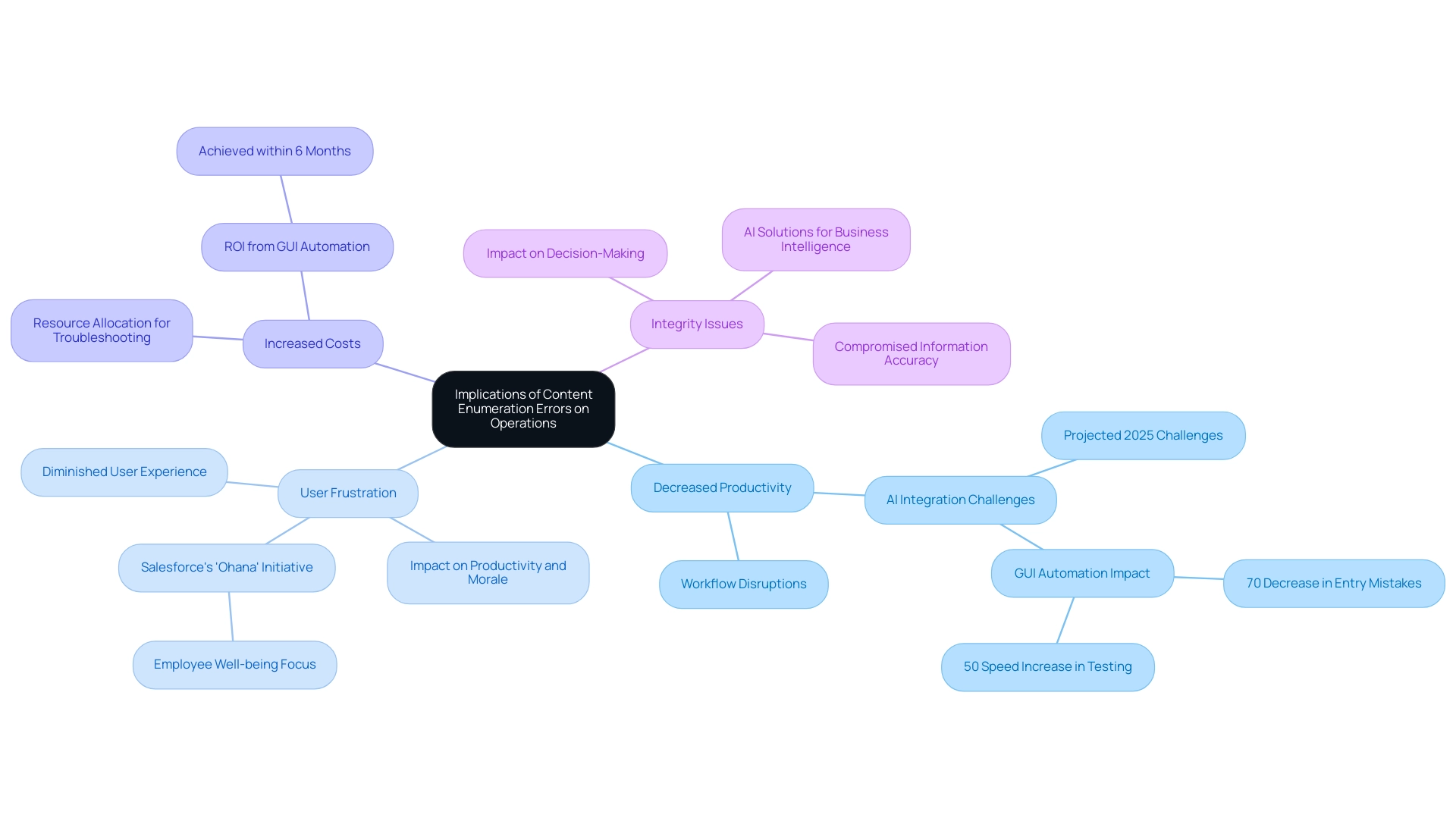
Best Practices for Resolving Content Enumeration Errors
To effectively resolve content enumeration errors, adopting a comprehensive approach is essential, incorporating the following best practices:
-
Regular Maintenance: Routine checks and updates on both software and hardware are crucial in preventing errors. Regular maintenance not only enhances system performance but also significantly decreases the likelihood of encountering enumeration issues. Statistics indicate that organizations prioritizing regular maintenance experience a marked decrease in operational disruptions, with 41% of maintenance challenges stemming from insufficient resources or staff. This highlights the critical need for adequate staffing and resource allocation to support maintenance efforts. Leveraging Robotic Process Automation (RPA) solutions, such as EMMA RPA, can streamline these tasks, allowing teams to focus on more strategic initiatives.
-
Information Backup: Regular information backups are vital to safeguard against data loss during troubleshooting procedures. A robust backup strategy ensures that critical information is preserved, facilitating quick recovery and minimizing downtime. Implementing AI-driven solutions can enhance data management practices, ensuring efficient and effective backup processes.
-
User Training: Educating users on proper system usage is fundamental in minimizing errors. Effective training programs can significantly decrease the occurrence of mistakes in content enumeration, as informed users are less likely to make errors that lead to system failures. In 2025, organizations investing in user training reported a 30% decrease in such mistakes. This underscores the importance of user engagement in the maintenance process. GenAI Workshops can provide tailored training to enhance user understanding and proficiency.
-
Error Logging: Establishing comprehensive logging mechanisms is essential for tracking issues and identifying patterns that can inform future prevention strategies. By examining recorded information, organizations can identify recurring issues and implement targeted solutions. Incorporating AI technologies can further improve flaw detection and analysis, leading to more proactive maintenance strategies.
-
Testing and Validation: Regular testing of systems for vulnerabilities and validating data integrity are critical practices that ensure smooth operations. Conducting these tests helps recognize potential vulnerabilities before they escalate into major issues, thus preserving system reliability. RPA can automate testing processes, ensuring thorough and consistent evaluations of system performance.
Incorporating these best practices not only reduces the risk of errors in content enumeration but also fosters a culture of proactive maintenance and continuous improvement within organizations. Real-world instances illustrate that companies with organized maintenance protocols encounter fewer mistakes and improved operational efficiency, emphasizing the significance of regular maintenance in software management. For instance, a case study on Computerized Maintenance Management Systems (CMMS) revealed that many implementations fail due to poor user engagement and unclear objectives, underscoring the need for effective training and management support.
Additionally, as Adrian Ababei noted, “A slow website frustrates users and increases bounce rates,” further reinforcing the necessity of regular maintenance and user training to ensure optimal system performance. Moreover, website security essentials, including regular updates and security audits, play a crucial role in preventing issues and maintaining system integrity.
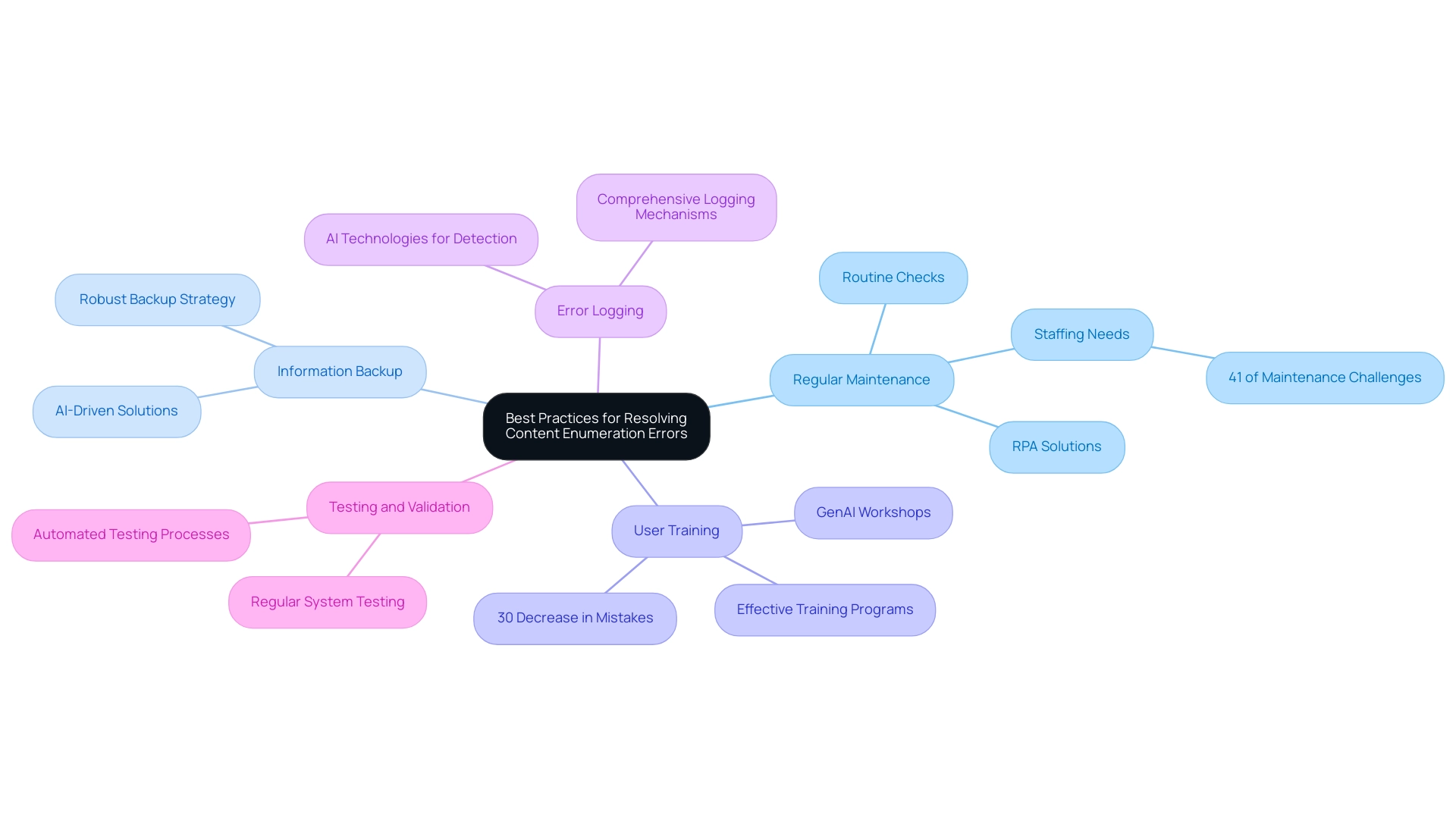
Leveraging Automation and AI to Prevent Enumeration Errors
Automation and AI play a pivotal role in preventing content enumeration errors through several key mechanisms:
-
Automating Routine Tasks: Minimizing manual input significantly reduces the risk of human error. This shift allows teams to focus on strategic initiatives rather than repetitive tasks, ultimately enhancing operational efficiency. Our Robotic Process Automation (RPA) solutions, such as EMMA RPA and Microsoft Power Automate, exemplify this shift by streamlining workflows and improving employee morale. Notably, a recent survey revealed that 45% of German respondents prioritize efficiency gains as the primary driver of automation, underscoring the importance of reducing administrative burdens.
-
Predictive Analytics: Leveraging AI to analyze usage patterns enables organizations to anticipate and mitigate potential issues before they arise. This proactive approach enhances accuracy and streamlines workflows. Significantly, 41% of participants in Germany express satisfaction with their current automation levels, indicating a growing acceptance of automation tools that help prevent mistakes.
-
Real-time Monitoring: Automated systems equipped with real-time monitoring capabilities can detect anomalies in information retrieval processes. This prompt oversight allows for rapid corrective measures, preventing counting mistakes from escalating into larger problems. The integration of AI in monitoring systems has proven effective across various sectors, including finance, where AI solutions enhance invoice approval processes by automatically validating invoices and identifying discrepancies. As Salesforce notes, “Ninety-three percent of CFOs have experienced shorter invoice processing times thanks to digital technologies and automation,” highlighting the tangible benefits of these technologies.
-
Enhanced Information Management: AI-driven tools significantly improve organization and accessibility, which are crucial in reducing the likelihood of errors in content enumeration. By ensuring that information is organized and easily retrievable, organizations can maintain high quality, vital for informed decision-making. A global survey indicated that 68% of respondents desire AI to streamline invoice approval and payment authorization, illustrating the demand for improved data management solutions. This directly addresses traditional bottlenecks in financial workflows, showcasing how AI can enhance operational efficiency.
Incorporating these technologies not only addresses current challenges but also positions organizations to thrive in a data-rich environment, where the ability to extract meaningful insights is paramount. As automation progresses, its significance in preventing errors in content enumeration will only grow, leading to improved operational efficiency and innovation.
To explore how our RPA solutions can specifically address your organization’s challenges, book a free consultation with us today.
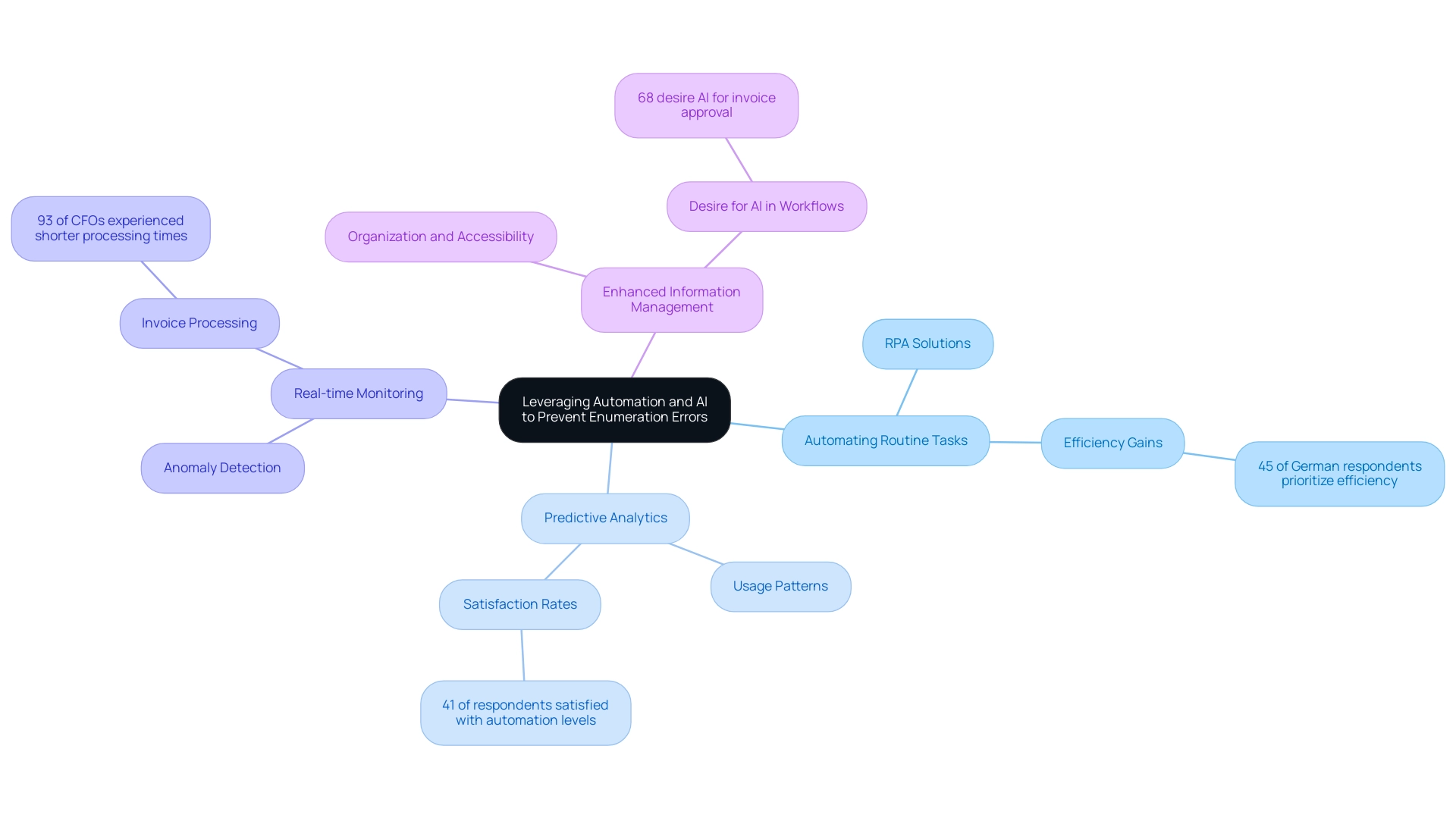
Measuring the Effectiveness of Solutions to Enumeration Errors
To effectively measure the success of solutions implemented for content enumeration errors, organizations must adopt a structured approach that encompasses key strategies:
-
Define Key Performance Indicators (KPIs): Establishing clear metrics is crucial. Organizations should focus on KPIs such as mistake frequency, tracking how often mistakes occur; resolution time, measuring the speed at which issues are addressed; and user satisfaction, gauging the overall experience of users interacting with the system. These metrics provide a quantifiable basis for assessing performance and guiding improvements. Notably, studies indicate that businesses employing robust measurement strategies report higher retention rates and customer loyalty, with user satisfaction scores significantly improving.
-
Conduct Regular Reviews: Periodic assessments of system performance and the effectiveness of implemented solutions are essential. By reviewing KPIs regularly, organizations can identify trends and make informed decisions about necessary adjustments. This practice not only helps maintain operational efficiency but also ensures that solutions remain aligned with evolving business needs, particularly in a rapidly evolving AI landscape, to avoid any errors in content enumeration.
-
Gather User Feedback: Actively collecting input from users is vital for understanding their experiences with the system. Surveys and feedback forms can reveal insights into user satisfaction and highlight areas needing improvement. Engaging users in this way fosters a culture of continuous improvement and ensures that solutions are user-centric, which is essential for leveraging Business Intelligence effectively.
-
Analyze Mistake Trends: Monitoring mistake patterns over time allows organizations to evaluate the impact of changes made to the system. By examining these trends, companies can pinpoint recurring problems and assess whether applied solutions, such as Robotic Process Automation (RPA), are successfully addressing the error in content enumeration. This data-driven approach supports informed decision-making and enhances overall operational efficiency.
In 2025, organizations that effectively track these KPIs can anticipate notable enhancements in user satisfaction regarding issue resolution. For example, a recent case study emphasized how a mid-sized company that adopted GUI automation to enhance operations experienced a 30% decrease in mistake frequency and a significant rise in user satisfaction scores. Furthermore, monitoring backlinks and PR mentions offers insights into brand authority and relevance, which can guide strategy and improve operational efficiency.
As Dr. Abdur Rahman states, “Measuring effectiveness is not just about numbers; it’s about understanding the impact of those numbers on user experience and operational success.” By utilizing these best practices, organizations can not only address counting issues more effectively but also promote growth and innovation in their operations.
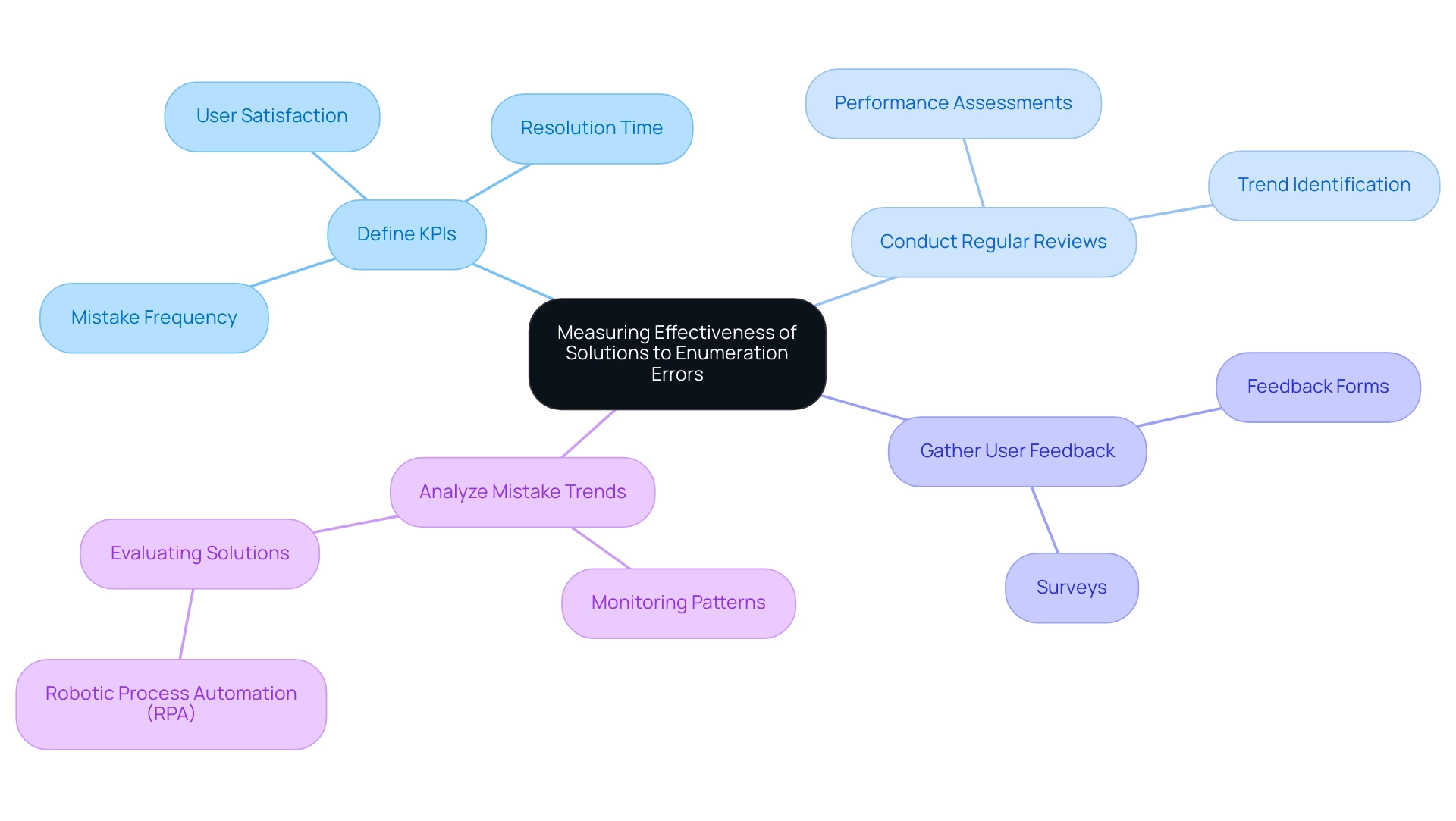
Fostering a Culture of Change to Combat Enumeration Errors
Fostering a culture of change is vital for effectively addressing issues related to error in content enumeration. Organizations can take several strategic steps to cultivate this environment:
-
Encourage Open Communication: Establishing a culture that promotes dialogue about errors and potential solutions is essential. Creating a safe space for employees to share their experiences not only helps in identifying issues but also fosters a collaborative atmosphere where solutions can be developed collectively. Leveraging Robotic Process Automation (RPA) can streamline communication processes, ensuring that feedback loops are efficient and effective.
-
Recognize and Reward Innovation: Acknowledging employees who actively contribute to problem resolution and process improvement can significantly enhance morale and motivation. Recognition can take various forms, from formal awards to simple shout-outs in team meetings, reinforcing the value of proactive problem-solving. Unresolved workplace conflicts can lead to employee turnover, with studies indicating that 30% of employees have left a company due to such issues. Thus, acknowledging contributions to issue resolution is essential for sustaining morale and retention, particularly in a swiftly changing AI environment where innovation is vital.
-
Provide Continuous Training: Ongoing education is crucial in keeping staff informed about best practices and emerging technologies. Regular training sessions can prepare employees with the skills necessary to navigate complex systems and decrease the chances of mistakes happening initially. Incorporating training on RPA and Business Intelligence tools can empower employees to leverage these technologies for enhanced operational efficiency.
-
Lead by Example: Management plays a pivotal role in fostering a culture of change. By showing a dedication to enhancement and openness, leaders can motivate their teams to adopt change and actively engage in issue resolution efforts. Organizations that align their leadership actions with their stated values and strategic priorities are more likely to foster high-performing cultures. The integration of tailored AI solutions can further support leaders in making informed decisions that drive growth and innovation.
Statistics reveal that organizations with a thriving culture experience employee satisfaction levels that are 102% higher than those without. This underscores the importance of cultivating an environment where open communication is prioritized. Furthermore, the quote from Chantel Sheaks emphasizes the need for supportive measures, stating that “emergency savings funds were one low-cost way to provide employees with a valuable safety net.”
By prioritizing open communication and a culture of change, businesses can significantly improve their processes for addressing the error in content enumeration, ultimately leading to enhanced operational efficiency and employee satisfaction.
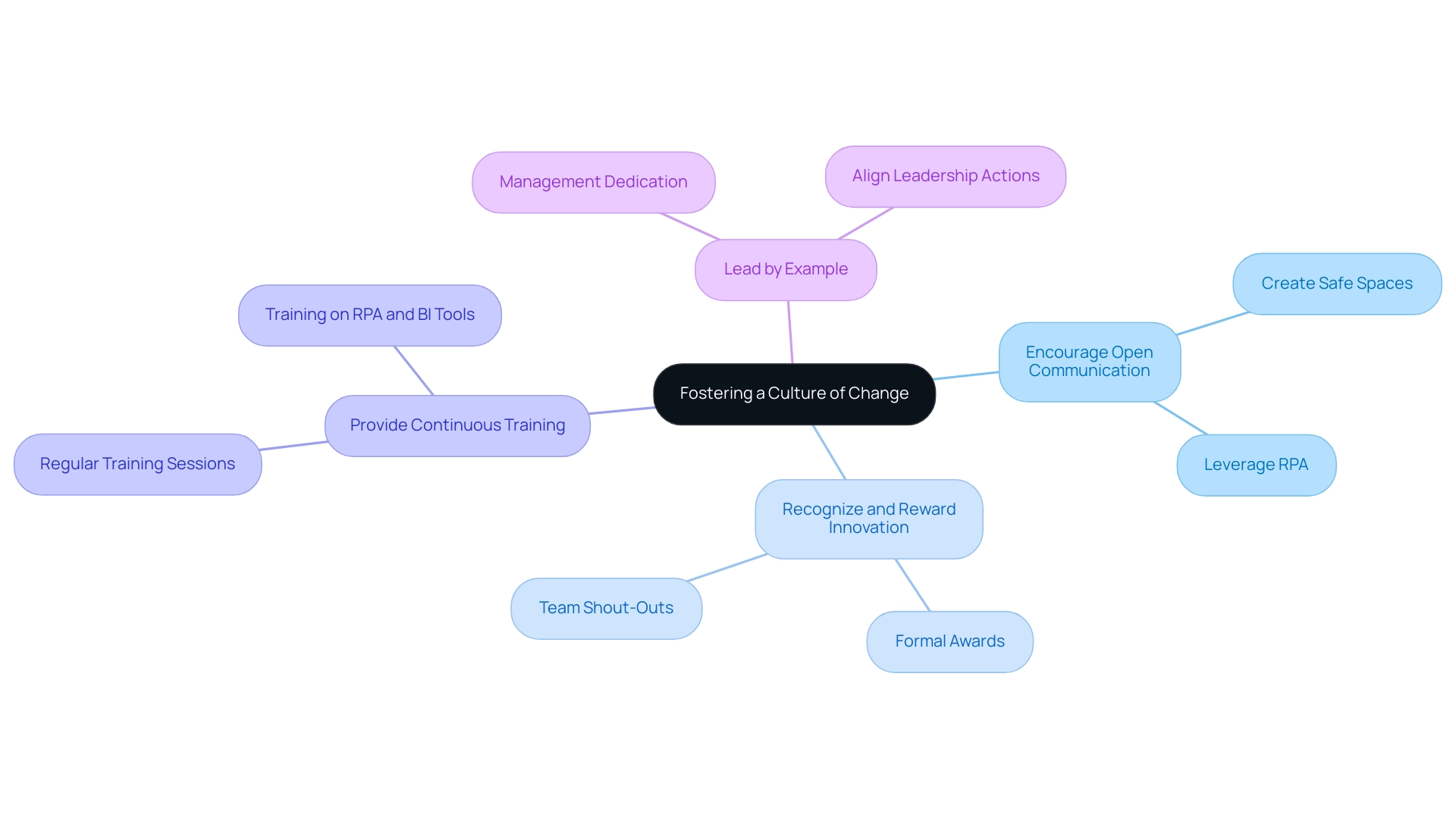
Conclusion
Content enumeration errors present substantial challenges for organizations across various sectors, adversely affecting user experience, productivity, and operational efficiency. By understanding the root causes of these errors—ranging from corrupted files and software bugs to network issues and user errors—businesses can implement targeted strategies to mitigate their effects. Adopting best practices such as:
- Regular maintenance
- Robust data backup protocols
- Comprehensive user training
enables organizations to significantly reduce the occurrence of these errors.
The implications of content enumeration errors extend beyond immediate disruptions; they can lead to decreased user satisfaction and increased operational costs. Case studies demonstrate that integrating automation and AI technologies not only streamlines data management processes but also enhances overall performance, providing organizations with a competitive edge. The successful application of these technologies, coupled with a proactive approach to error resolution, can transform data retrieval systems into resilient and efficient operations.
Ultimately, fostering a culture of change and continuous improvement is essential for effectively combating content enumeration errors. By encouraging open communication, recognizing innovation, and providing ongoing training, organizations can empower their teams to proactively address challenges. As businesses navigate the complexities of modern data management, prioritizing these strategies will ensure they not only overcome current obstacles but also thrive in an increasingly data-driven landscape. Embracing these changes is not just an operational necessity; it is a pathway to sustained success and user satisfaction.
Frequently Asked Questions
What are content enumeration errors?
Content enumeration errors occur when a system fails to accurately recognize or access necessary material during information retrieval processes, leading to issues such as missing data or incorrect listings.
In what contexts can these errors occur?
These errors can manifest in various settings, including gaming, software applications, and information management systems.
How do content enumeration errors impact user experience?
Content enumeration errors can significantly frustrate users, with statistics indicating that nearly 30% of users reported retrieval failures in 2025, leading to decreased engagement and satisfaction.
Can you provide an example of a case study involving content enumeration errors?
A notable case involved a major gaming platform that faced extensive loading problems, resulting in a 25% decline in active users during peak times. This prompted a review of their information retrieval processes and the implementation of better error-handling mechanisms.
What are some common causes of content enumeration errors?
Common causes include: Corrupted files, Software issues, Configuration problems, Network problems, User mistakes.
How can organizations address these content enumeration issues?
Organizations can resolve these issues by conducting thorough analyses of retrieval pathways, ensuring correct configurations, and implementing automated monitoring tools, such as Robotic Process Automation (RPA).
What role does technology play in improving information retrieval processes?
Technology, particularly AI and automation, helps organizations optimize information retrieval, reducing counting mistakes and improving overall performance.
What are the benefits of using machine learning and RPA in addressing content enumeration errors?
Implementing machine learning and RPA can lead to significant reductions in errors, as demonstrated by a leading software company that reduced errors by 85%, enhancing user experience and operational effectiveness.
How has the increase in cyber threats affected information retrieval systems?
The rise in DDoS attacks, which increased by 15% in 2023, underscores the need for enhanced security protocols to protect connected devices and improve the information retrieval landscape.
What proactive measures do industry leaders recommend for managing content enumeration errors?
Industry leaders advocate for integrating automated monitoring tools to detect potential issues early, thus preventing escalation and maintaining user trust and operational efficiency.